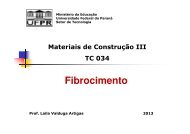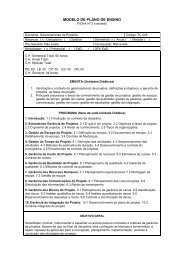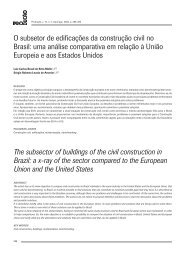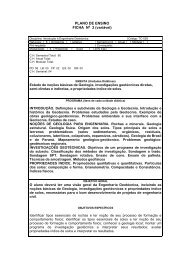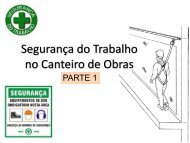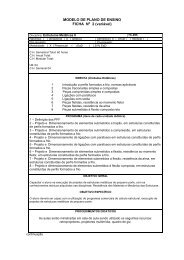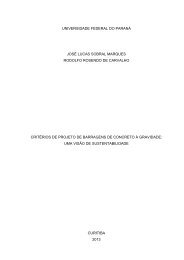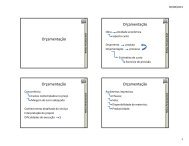TC 058 â PONTES E ESTRUTURAS ESPECIAIS â NOTAS ... - DCC
TC 058 â PONTES E ESTRUTURAS ESPECIAIS â NOTAS ... - DCC
TC 058 â PONTES E ESTRUTURAS ESPECIAIS â NOTAS ... - DCC
You also want an ePaper? Increase the reach of your titles
YUMPU automatically turns print PDFs into web optimized ePapers that Google loves.
<strong>TC</strong> <strong>058</strong> – <strong>PONTES</strong> E <strong>ESTRUTURAS</strong> <strong>ESPECIAIS</strong> – <strong>NOTAS</strong> DE AULA<br />
Somente em 1912, é que se começou a adotar pontes em viga e pontes em pórtico,<br />
mas, no entanto, apenas para vãos de até 30 m. Simultaneamente, as pontes em arco<br />
de concreto armado atingiam dimensões cada vez maiores. Em 1941-1945 foi<br />
construída, na Suécia, a ponte de “Sando” com 280 m de vão livre.<br />
As pontes de concreto protendido surgiram a partir de 1938, aproximadamente, porém<br />
o seu desenvolvimento foi interrompido pela guerra. Com cabos inclinados já se havia<br />
atingido em 1977 vãos de cerca de 300 m (Ponte Pasco-Kennewick, sobre o rio<br />
Columbia, projeto de F. Leonhardt).<br />
Capítulo 5 – O DESENVOLVIMENTO DO PROJETO DE UMA PONTE<br />
Sumário<br />
5.1 – DADOS PARA O PROJETO<br />
5.2 – O PROCESSO DE CRIAÇÃO NO PROJETO DE GRANDES <strong>PONTES</strong><br />
5.3 – A ELABORAÇÃO DO PROJETO PARA EXECUÇÃO<br />
Capíulo 6 – TIPOS ESTRUTURAIS DAS <strong>PONTES</strong> DE CONCRETO<br />
Sumário<br />
6.1 – <strong>PONTES</strong> EM VIGA<br />
6.1.1. – Sistemas Estruturais<br />
6.1.2 – Formas das Vigas<br />
6.2 – <strong>PONTES</strong> EM PÓRTICOS<br />
6.2.1 – Sistemas Estruturais<br />
6.2.2 – Formas dos Pórticos<br />
6.3 – <strong>PONTES</strong> EM ARCO<br />
6.3.1 – Sistemas Estruturais<br />
6.3.2 – Formas dos Arcos<br />
6.4 – <strong>PONTES</strong> PÊNSEIS<br />
6.5 – <strong>PONTES</strong> ESTAIADAS<br />
2/3




